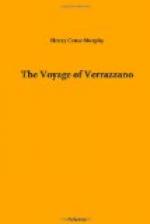“Departing from thence, we kept along the coast, steering northeast, and found the country more pleasant and open, free from woods, and distant in the interior, we saw lofty mountains but none which extended to the shore. Within fifty leagues we discovered thirty-two islands, all near the main land, small and of pleasant appearance, but high and so disposed as to afford excellent harbors and channels, as we see in the Adriatic gulf, near Illyria and Dalmatia. We had no intercourse with the people, but we judge that they were similar in nature and usages to those we were last among. After sailing between east and north one hundred and fifty leagues more, and finding our provisions and naval stores nearly exhausted, we took in wood and water, and determined to return to France, having discovered (avendo discoperto) VII, [Footnote: “The Ms. has erroneously and uselessly the repetition VII, that is, 700 leagues.” Note, by M. Arcangeli. It is evident that VII is mistakenly rendered 502 in the transcription used by Dr. Cogswell.] that is, 700 leagues of unknown lands.”
The exact point at which they left the coast, and to which their discovery is thus stated to have extended, is given in the cosmography which follows the narrative, in these words:
“In the voyage which we have made by order of your majesty, in addition to the 92 degrees we ran towards the west from our point of departure (the Desertas) before we reached land in the latitude of 34, we have to count 300 leagues which we ran northeastwardly, and 400 nearly east along the coast before we reached the 50th parallel of north latitude, the point where we turned our course from the shore towards home. Beyond this point the Portuguese had already sailed as far as the arctic circle, without coming to the termination of the land.”
That this latitude must be taken as correctly determined follows from the representation of the letter, that they took daily observations of the sun and made a record of them, so that no material error could have occurred and remained unrectified for over twenty-four hours; and from the presumption that they were as capable of calculating the latitude as other navigators of that period, sent on such purposes by royal authority, like Jacques Cartier, whose observations, as the accounts of his voyage to this region show, never varied half a degree from the true latitude. The fiftieth parallel strikes the easterly coast of Newfoundland three degrees north of Cape Race, and to that point the exploration of Verrazzano is therefore to be regarded as claimed to have been made. [Footnote: Damiam de Goes, Chronica do felicissimo rei Dom Emanuel parte I. C. 66. (Fol., Lisboa, 1566)]




